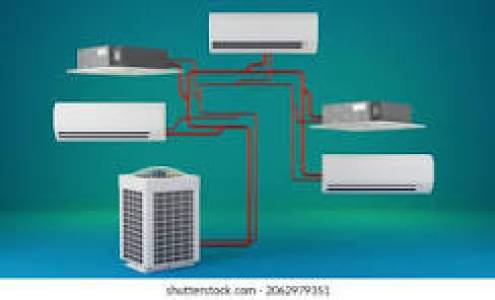Description
VRV/VRF Piping for Split Air Conditioning Systems: High-Efficiency, Flexible Solutions
This comprehensive guide details the crucial role of piping in VRV (Variable Refrigerant Volume) and VRF (Variable Refrigerant Flow) systems, a key component of modern split air conditioning solutions for commercial and large residential applications. Understanding this intricate system is paramount for efficient installation, optimal performance, and long-term reliability.
What is VRV/VRF Piping?
Unlike traditional split systems with individual refrigerant lines for each indoor unit, VRV/VRF systems employ a sophisticated network of refrigerant piping that connects a single outdoor unit (heat pump or chiller) to multiple indoor units of varying capacities and types. This network allows for precise control and efficient distribution of refrigerant, leading to significant energy savings and enhanced climate control.
Key Components of the Piping System:
- Refrigerant Piping: High-quality copper tubing, typically sized according to the system's capacity and the length of the refrigerant lines. Precise sizing is critical for optimal performance and prevents pressure drops that could impact efficiency. Different diameters are used depending on the system’s capacity and the length of the lines.
- Insulation: Thick, high-performance insulation is essential to minimize heat transfer and prevent condensation. This insulation dramatically improves energy efficiency and prevents refrigerant leakage. Common insulation materials include polyurethane foam and polyethylene foam.
- Liquid Line and Suction Line: These are the two primary refrigerant lines. The liquid line carries high-pressure, liquid refrigerant from the outdoor unit to the indoor units, while the suction line carries low-pressure, gaseous refrigerant back to the outdoor unit. Careful installation and proper slope are critical to ensure efficient refrigerant flow.
- Refrigerant Interconnects & Fittings: High-quality, brazed or compression fittings ensure leak-proof connections throughout the piping system. The use of appropriate flaring tools and brazing techniques is crucial for durability and safety.
- Expansion Devices: These devices regulate the flow of refrigerant to maintain optimal pressure and temperature within the system. They are essential for efficient operation and system longevity.
- System Valves & Manifolds: These components allow for system service, maintenance, and isolation of individual indoor units. Service valves facilitate refrigerant charging, evacuation, and pressure testing.
Benefits of Optimized VRV/VRF Piping:
- Energy Efficiency: Properly sized and insulated piping minimizes energy loss during refrigerant transport, leading to significant savings on energy bills.
- Improved Climate Control: The precise distribution of refrigerant ensures consistent and comfortable temperatures in all connected indoor units, regardless of their location or capacity.
- Flexibility and Scalability: VRV/VRF systems can accommodate a wide range of indoor units and configurations, making them highly adaptable to various building designs and needs.
- Reduced Environmental Impact: Enhanced energy efficiency contributes to a smaller carbon footprint, aligning with sustainability goals.
Considerations for Installation:
- Refrigerant Type: Specific piping considerations and best practices vary depending on the refrigerant used (R32, R410A, etc.).
- Piping Lengths: Longer piping lengths necessitate careful sizing and insulation to mitigate pressure drops and heat gain.
- Elevation Changes: Proper slope and elevation considerations are crucial for efficient refrigerant flow and prevent liquid slugging.
- Professional Installation: VRV/VRF piping systems require specialized knowledge and expertise. Professional installation by qualified technicians is vital for ensuring optimal performance, safety, and warranty compliance.
Conclusion:
The VRV/VRF piping system is the backbone of any successful variable refrigerant volume/flow air conditioning installation. Careful planning, precise execution, and the use of high-quality components are crucial for maximizing efficiency, reliability, and longevity. Choosing the right materials and ensuring professional installation are essential steps in realizing the full potential of this advanced technology.
